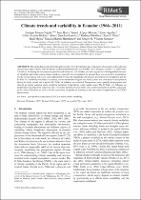Climate trends and variability in Ecuador (1966–2011)
Metadata
Show full item recordAbstract
This study detects climate trends and variability from precipitation and temperature observations in Ecuador and assesses their links to the El Niño Southern Oscillation (ENSO) for the period 1966–2011, using the El Niño 1+2 and El Niño 3.4 indices. Excluding the Amazonian region (for which there is a lack of data), two main regions were distinguishable in terms of variability and trends among climate variables, especially for precipitation. In general, there was no trend in precipitation for the coastal region, and a very close relationship between the magnitude and seasonal distribution of precipitation and the El Niño 1+2 variability was found. In contrast, for the mountainous region (the Andes), there was an increase of precipitation during the study period, and a signal of El Niño 3.4 influence was detected. Temperatures were spatially homogeneous and showed an intense warming trend, except for maximum temperatures in the coastal region. The El Niño 1+2 influence on temperature was large from January to July. The results provide evidence of the close control exerted by the ENSO, especially in the coast of Ecuador, as well as for the occurrence of significant warming across the country independent of the ENSO phenomenon
The following license files are associated with this item:








